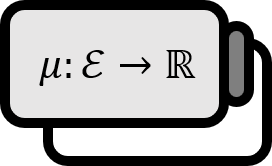Borel Set
Definition 1
Let $\mathcal{F}$ be called the sigma field of the Euclidean space $\mathbb{R}$.
$\displaystyle \mathcal{B} : = \bigcap \left\{ \mathcal{F} : \mathcal{I} \subset \mathcal{F} \right\}$ is said to be generated by the set of all intervals $\mathcal{I}$. $B \in \mathcal{B}$ is called the Borel Set, and $\mathcal{B}$ is referred to as the Borel sigma field.
- $\mathcal{I}$ is the set of all intervals.
Description
In simple terms, it is the smallest sigma algebra that possesses every possible interval. One should think of it as an entity that keeps everything that’s needed by eliminating what’s unnecessary.
Contrary to its complex definition, Borel sets have various uses, especially in describing probability theory. According to their definition, Borel sets appear as unions or intersections between intervals, examples of which include intervals, open sets, and countable sets. It’s crucial to grasp the true intention behind the Borel sigma field. It’s not merely important because it deals with ‘intervals’, but because it consists of sets formed by ‘open’ and ‘closed’ sets.
By contemplating Borel sets, we can apply various theorems in topology. Even the concept of a topological space itself is sufficiently general and abstract for many applications in measure theory. Accepting this discussion makes it easier to understand the Borel sigma field as follows:
- The Borel sigma field simply sets limits to use topology.
- The Borel sigma field is relatively small, so there isn’t much to consider.
- Thus, it’s common to assume only the Borel sigma field in various theorems.
Intersection of Sets of Sets of Sets
Honestly, the definition of the Borel sigma field is repulsive. $\mathcal{I}$ is naturally a set of sets since an interval is a set. But when we collect sigma fields that include $\mathcal{I}$, it becomes a set of sets of sets. The Borel sigma field is then the intersection of these. It’s normal to find it hard to understand.
Theorems
Let $\mathcal{M}$ be a sigma algebra, that is, some sigma field containing every interval as the set of measurable sets of $X = \mathbb{R}$. The following holds:
- [1] The intersection of σ-fields is a σ-field, and therefore $\mathcal{B}$ is also a σ-field.
- [2]: $\mathcal{B}$ is the smallest σ-field that includes all intervals.
- [3]: $\mathcal{N} \subseteq \mathcal{B} \subsetneq \mathcal{M}$
- [4]: For every $ E \in \mathcal{M}$, there exists $B \in \mathcal{B}$ that satisfies the following: $$ E \subset B \\ m(E ) = m(B) \\ m(B \setminus E) = 0 $$
Generalization
Capinski. (1999). Measure, Integral and Probability: p40. ↩︎
